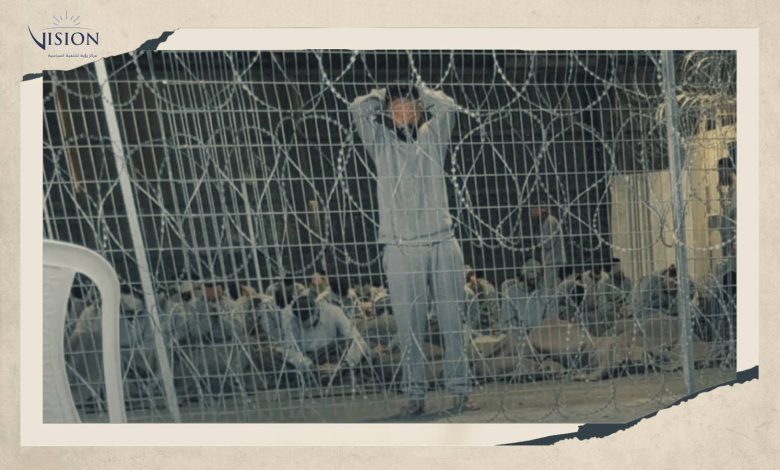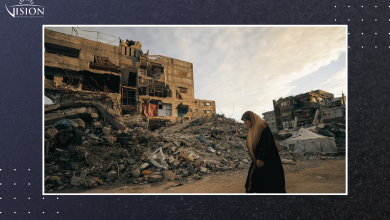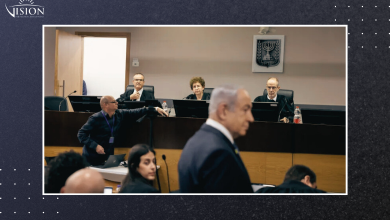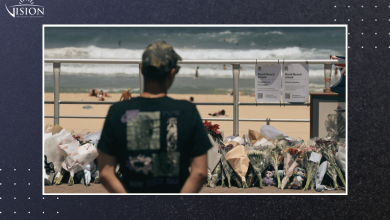The Continuation of Genocide in the Occupation’s Prisons

Kareem Qurt
The genocide executed by the Israeli occupation against the Palestinian population in the Gaza Strip manifests in numerous dimensions. While certain atrocities are perpetrated openly and broadcasted live—such as massacres, starvation, deprivation of water, the destruction of the healthcare sector, and recurrent forced displacements—other aspects remain concealed from public scrutiny, with one of the most grievous being the treatment of Gaza prisoners within Israeli detention centers and prisons.
With the repeated release of several detainees from Gaza, there has been a growing body of testimonies that reveal the extensive torture, psychological and physical abuse, deprivation, and a myriad of other violations endured by the detainees. It is critical to emphasize that these accounts only scratch the surface of the profound suffering experienced by prisoners within these facilities. In addition, recent reports and journalistic investigations have begun to systematically document the treatment of Gaza detainees in Israeli prisons.
Although the overall conditions for Palestinian prisoners in Israeli custody have markedly deteriorated since October 7, 2023, the situation of Gaza detainees, in particular, is significantly worse, with their suffering far exceeding that of other Palestinian prisoners by multiple orders of magnitude. This alarming situation prompts serious inquiries into the specific conditions and violations they endure, the legal framework under which the occupying state administers the detainees from Gaza, and the underlying factors that have facilitated the imposition of such severe violence and punitive measures upon them.
“Sde Teiman” as an Exemplar Case
The “Sde Teiman” camp has emerged with an infamous reputation as a detention site for Gaza prisoners, particularly since the onset of the genocidal war against the Gaza Strip. Originally established as a military camp by the occupation forces, this site houses various military units, command centers, and brigades of the Israeli army. The state of Israel inherited this camp from the British Mandate and repurposed it as a military base in the 1950s. The camp’s designation, “Sde Teiman,” or “Field of Yemen,” originated from its historical use in facilitating the transportation and assimilation of Yemeni Jews during that period.
The Israeli military began utilizing this camp as a detention center for Gaza prisoners following the 2008/2009 assault, during which the army issued orders designating it as a holding facility for Gazans captured during the ground invasion of the Strip. This practice was repeated during the 2014 offensive, as reported by Haaretz, which indicated that the occupying forces detained 270 Palestinians in the “Sde Teiman” camp during their ground operations in Gaza.
At the outset of the genocidal war on Gaza, the Israeli Minister of Defense issued a military order identifying the camps “Sde Teiman,” “Ofer,” and “Anatot” as detention centers for Gaza prisoners. Among these, “Sde Teiman” has emerged as the most notorious and infamous. The camp is divided into two sections: a detention center for prisoners and a field hospital for treating the wounded. Since the early days of the genocidal war on Gaza, numerous testimonies have surfaced, detailing the torture and horrific conditions endured by the prisoners, both within the detention center and the field hospital.
Due to its global notoriety, five Israeli human rights organizations petitioned the Israeli Supreme Court in late May to close the camp, following the uproar caused by the torture testimonies that emerged from it. These accounts came not only from former prisoners but also from Israeli medical staff who had worked there. On May 11, CNN published a report containing testimonies from nurses and paramedics who had worked in the camp, describing the dire conditions faced by the prisoners. In response, the occupation authorities stated that they were in the process of redistributing the prisoners held in “Sde Teiman” to other prisons, particularly the “Ofer” detention center, and improving the conditions within the camp, given its role as a preliminary examination station for Gaza prisoners before decisions are made regarding their release or transfer to other prisons.
The incident at “Sde Teiman” camp on July 29 once again brought to light the pervasive violations faced by Gaza detainees in Israeli detention centers, particularly at “Sde Teiman.” A unit of the Israeli military police arrived at the camp to arrest several soldiers following reports of sexual assault and gang rape of a Gaza prisoner. The situation escalated when hundreds of far-right Israeli supporters stormed the camp to prevent the investigation of the soldiers, and later, the Beit Lid base where the investigation was taking place. Haaretz reported on the gang rape of a prisoner that resulted in severe bleeding and serious injuries, rendering him unable to stand or move, which necessitated the investigation of the involved soldiers.
Despite the infamy surrounding the “Sde Teiman” detention center as one of the most notorious Israeli prisons, it merely serves as a grim exemplar of the broader network of facilities where Gazan detainees are held. In these detention centers, prisoners endure severe torture, inhumane treatment, sexual assault, and deprivation of the most basic rights. Khaled Mahajneh, a lawyer representing the Palestinian Prisoners’ Affairs Commission, reported that the “Ofer” camp contains two sections ominously named “Hell” and “Inferno,”specifically designated for the torture of Gaza prisoners transferred from “Sde Teiman.” The conditions in these sections, particularly regarding the brutality of the torture and the deprivation of basic needs such as food, clothing, and hygiene, are reported to be exceptionally dire.
Nevertheless, “Sde Teiman” remains the most infamous of these detention centers, according to the same lawyer who has visited this and other similar facilities. The majority of harrowing accounts of brutal torture and sexual assault emanate from “Sde Teiman.” To underscore the severity, among the 54 prisoners who died in Israeli custody by the end of June, 36 perished within the confines of “Sde Teiman.”
The international outcry sparked by testimonies of torture and severe human rights violations at “Sde Teiman,” documented by global human rights organizations such as the Euro-Mediterranean Human Rights Monitor, has led to a concerted effort by Israeli authorities—including intellectuals, media figures, and human rights defenders—to frame these incidents as isolated events, limited to specific military units or technical procedures that are subject to legal and “ethical” debate. This narrative was evident in the Israeli military police’s attempt to arrest and later investigate the soldiers accused of raping a Palestinian prisoner in “Sde Teiman.” The Israeli authorities’ approach and the subsequent investigation into the soldiers likely stem from a concern that the International Criminal Court might issue arrest warrants for these soldiers, prompting the state to appear as though it is fulfilling its legal and human rights obligations.
Sexual Torture as a Systematic Policy
The range of torture methods, deprivation, abuse, and humiliation inflicted on Gaza detainees by Israeli soldiers and prison guards includes a particularly heinous chapter of crimes: sexual torture. The rape of a prisoner at “Sde Teiman” was not an isolated incident. Released detainees’ testimonies indicate that sexual torture is a systematic policy employed against both male and female Gaza prisoners. This policy begins at the moment of arrest, with Israeli soldiers routinely forcing Gaza detainees to strip almost completely, and sometimes entirely, naked during their apprehension. The sexual torture continues within the detention centers.
The process of sexual torture starts with a policy of strip searches for newly arrived prisoners. Although strip searches have long been a standard practice in Israeli prisons, the practice has escalated to include prisoners being forced to strip naked in front of each other, and female prisoners being violated by being forced to strip in front of male soldiers. A 64-year-old female detainee from Gaza recounted how she and other female prisoners were stripped and searched naked by female soldiers in the presence of male Israeli soldiers. The violence does not end there; Gaza prisoners have been subjected to severe sexual violence and rape, which, when combined with brutal physical torture, has resulted in the deaths of several prisoners.
According to Khaled Mahajneh, the lawyer representing the Palestinian Prisoners’ Affairs Commission, who has conducted limited visits to Gaza prisoners in both “Sde Teiman” and “Ofer” camps, rape and sexual torture are systematically inflicted upon the detainees with extreme brutality, often resulting in death or severe injury. Mahajneh reported that Israeli soldiers have raped prisoners and subjected them to sexual assaults in the presence of other detainees. In one particularly egregious case, a prisoner was raped with a fire extinguisher hose that Israeli soldiers forcibly inserted into his rectum. In another instance, a prisoner was tortured while naked by being subjected to electric shocks on his sensitive areas, also in front of other detainees. Additional testimonies reveal that soldiers forced prisoners to sit on metal objects, causing deep wounds and severe bleeding in the rectal area.
The full extent of the crimes committed by the Israeli occupation against Gaza detainees continues to emerge with each new release of prisoners or during each visit by a lawyer. It is certain that many more truths will be revealed over time, particularly concerning the sexual torture of Gaza prisoners. It must be recognized that the issues of sexual torture and rape are highly sensitive in Palestinian Arab society, leading many victims to remain silent due to the stigma associated with these experiences.
Nevertheless, it is imperative that this issue receives the utmost attention, with efforts directed toward documenting these crimes, forming investigative committees, and filing cases against the Israeli state in international courts. One of the central falsehoods propagated by the occupation to justify its crimes against the Gaza Strip is the fabricated claim of sexual assaults during Operation Al-Aqsa Flood on October 7, 2023. Although some international organizations and institutions continue to perpetuate this lie, despite investigations by several global newspapers that have debunked it, there remains a disturbing global silence and a disregard by human rights organizations for the testimonies detailing sexual violence in Israeli prisons.
The Exceptionality of the Law
The Israeli occupation authorities detain Palestinians from the Gaza Strip under the “Unlawful Combatants Law,” which was enacted by the Israeli Knesset in 2002. This law was originally designed to enable the indefinite detention of Lebanese prisoners without charge, using them as bargaining chips in potential exchange deals with the Lebanese resistance, following a 2000 ruling by the Israeli Supreme Court that prohibited the administrative detention of Lebanese prisoners for bargaining purposes.
Under this law, an unlawful combatant is defined as “a person who participates in hostile activities against the State of Israel, either directly or indirectly, or is affiliated with a force that carries out hostile activities against the State of Israel, and who does not meet the criteria applicable to prisoners of war under international human rights law, as outlined in Article 4 of the Third Geneva Convention of 1949 concerning prisoners of war.” The law stipulates that the release of such an individual would endanger state security as long as the hostilities against Israel continue, unless proven otherwise.
Furthermore, according to this law, the criteria for classifying prisoners of war require that they belong to the regular armies of states. Consequently, resistance fighters or Palestinian detainees do not qualify as prisoners of war, implying that the occupation authorities do not even respect the law they have enacted.
The occupation authorities have amended this law several times, with the most recent amendment occurring on October 13, 2023, just days after the war on Gaza began. The amendments generally extend the timeframes stipulated for detention procedures. For example, the period allowed for issuing a detention order has been increased from 7 days to 21 days, meaning that a person can now be detained for this extended period without an official detention order. Additionally, the time available for appealing a detention order has been extended from 14 days to 30 days, effectively preventing a detainee from challenging their detention for a month.
The issue of detaining Gazans is entirely detached from any legal framework. The Israeli narrative claims that the detainees belong to the elite forces of Al-Qassam, a claim that has accompanied all arrests since October 7. The term “elite” has been portrayed in Israeli discourse as the epitome of evil—depicting those involved as perpetrators of heinous crimes such as rape, murder, and the burning of infants. Consequently, individuals labeled as such are considered outside the bounds of any human or legal convention. However, there is no evidence to suggest that the detainees are connected to the resistance in any form. In many documented cases, the detainees were unarmed civilians, including elderly individuals, children, women, as well as medical and journalistic personnel, who were arrested from shelters and hospitals.
Moreover, the treatment of Gaza prisoners—characterized by torture, violations, and humiliation—stands in direct contradiction to the law itself, which stipulates in Article 10 that “the detainee shall be held in conditions that do not harm their health or dignity.” However, the reality within the occupation’s detention centers is starkly different, indicating that the entire situation operates outside any legal framework, including Israeli law itself.
Consequently, the physical, psychological, and sexual torture, starvation, killings, and other atrocities inflicted upon Gaza prisoners cannot be understood within the framework of Israeli colonial laws. A fundamental approach to comprehending this situation can be found in the statement by Israeli Defense Minister Yoav Gallant, who referred to Gazans as “human animals.” Although this description may seem like a spontaneous outburst of anger, it actually points to a fully integrated colonial legal structure that has imposed a “state of exception” on Palestinians, particularly in the Gaza Strip, as articulated by Giorgio Agamben. In this context, Israel, as the sovereign power, determines who falls within the bounds of the law—this includes international humanitarian law, where, for example, Israeli law defines an unlawful combatant as someone who does not meet the criteria applicable to prisoners of war under international human rights law—and who falls outside of it, effectively placing them in a “state of exception,” which simply means the suspension of the legal order.
In this “state of exception,” the individual becomes homo sacer—a person who is outlawed or outcast, living a “bare life” without any political or social existence, but merely a biological one. This aligns with Gallant’s characterization of Gazans as “human animals,” whose mistreatment does not warrant any legal or moral accountability. Consequently, Gaza prisoners are tortured not for investigative purposes or to extract information but for sheer vengeance, entertainment, and the fulfillment of deep-seated animosities. Many detainees are released after weeks or months without any charges being brought against them, yet during their detention, they endure all forms of torture. This goes beyond satisfying the vengeful desires of the occupying soldiers, extending to the gratification of the occupying public itself. The Euro-Mediterranean Human Rights Monitor has documented testimonies from detainees indicating that Israeli forces brought settlers, in groups, to watch the torture of prisoners, film them as they were stripped naked, subjected to torture, humiliation, electric shocks, and other abuses.
Conclusion
The pressing question now is how the occupying state has managed to treat Gaza prisoners in such a manner. In this context, it is crucial to understand that the crimes committed against Gaza prisoners are part and parcel of the broader genocide that the occupation has been executing against the Gaza Strip for the past ten months. The occupation state’s ability to continue committing genocide is the root cause of all subsequent crimes. This capability is tied to several factors, succinctly summarized by an elderly man from Gaza, who, while sitting before the ruins of his home, was asked by a journalist about his condition. He responded: “Someone was stabbed in the stomach and cried out, ‘Oh, my back!’ He was told, ‘You mean your stomach.’ He replied, ‘If I had a back [support], I would not have been stabbed in the stomach.'”
The implication here is that the global and Arab indifference to the genocide committed by the Israeli occupation, coupled with the failure of Arab states to take serious measures to confront it, has allowed the occupation state to persist in its crimes against the Palestinian people, especially in the Gaza Strip. In this context, the occupation state itself represents a “state of exception,” as international laws do not apply to it, nor is it held accountable for its crimes. It is politically shielded, financially supported, and militarily and media-backed by the United States and its allies, while the Arab and Islamic world largely remains passive. As long as the occupation state enjoys this status, placing it above the law, the crimes, massacres, and genocide will continue unabated.





